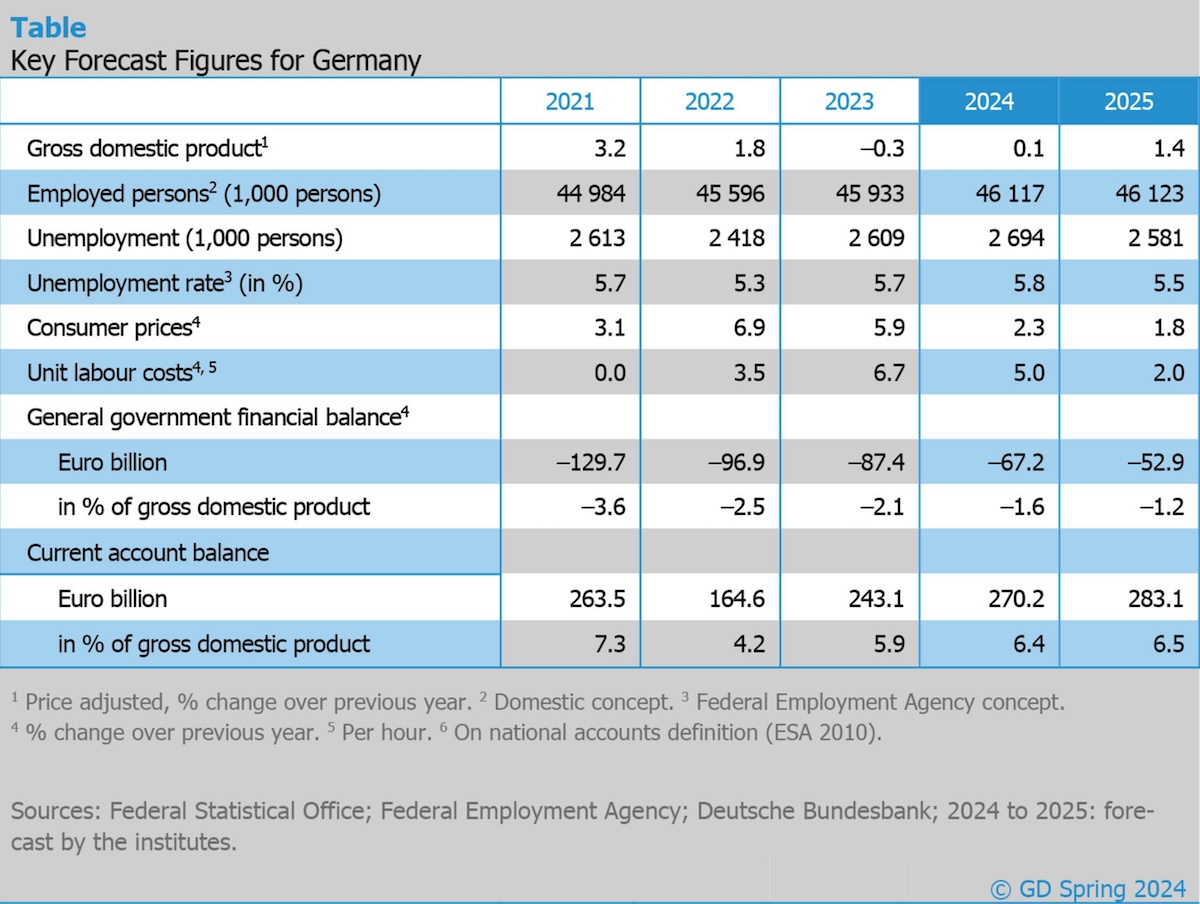April 2024 | In a Joint Economic Forecast, German economic research institutes revise forecast significantly downwards. Economic output is currently at a level that is barely higher than before the pandemic.
According to Germany’s five leading economic research institutes, the country’s economy shows cyclical and structural weaknesses. In their spring report, they revised their GDP forecast for the current year significantly downward to 0.1%. In the recent fall report, the figure was still 1.3%. Expectations for the coming year are almost unchanged at 1.4% (previously 1.5%). However, the level of economic activity will then be over 30 billion euros lower due to the current weak phase.
“Cyclical and structural factors are overlapping in the sluggish overall economic development. Although a recovery is likely to set in from the spring, the overall momentum will not be too strong,” says Stefan Kooths, Head of Economic Research at the Kiel Institute for the World Economy.
In the current year, private consumption will become the most important driving force for the economy, followed by stronger exports in the coming year.
Economic output is currently at a level that is barely higher than before the pandemic. Since then, productivity in Germany has been at a standstill. There have recently been more headwinds than tailwinds in the domestic and foreign economies.
Private consumption picked up later and less dynamically than previously expected by the Joint Economic Forecast Project Group. German exports declined despite rising global economic activity, primarily because demand for capital and intermediate goods, which are important for Germany, was weak and price competitiveness for energy-intensive goods suffered.
Ongoing uncertainty about economic policy is weighing on corporate investment, which is likely to remain at the 2017 level despite the expected upturn in the coming year.

Key Forecast Figures Germany
Outlook on Wages, Prices, and the Labor Market
Nominal effective wages are expected to increase by 4.6% and 3.4% in 2024 and 2025 respectively. This means that real wages will increase over the entire forecast period and make up for the losses from 2022 and the first half of 2023. However, the level seen at the end of 2021, before the drastic surge in inflation, is not expected to be reached until the second quarter of 2025.
Overall, the institutes expect consumer prices to rise by 2.3% in the current year and by 1.8% in the coming year. Adjusted for the dampening effect of energy prices, core inflation rates are 2.8% (2024) and 2.3% (2025).
A robust labour market is supporting consumption-related upward forces. Although real unit labour costs are rising again significantly in the wake of wage increases, they remain supportive for labour demand.
Unemployment is likely to rise only slightly and fall again starting from spring onwards. Over the course of the year, the unemployment rate is likely to be 5.8% (2024) and 5.5% (2025).
The deficits in the general government budget in relation to economic output will fall from 2.1% in the previous year to 1.6% (2024) and 1.2% (2025). The public sector revenue ratio will reach record levels for Germany as a whole in the two forecast years at 47.5% and 48.4% respectively.
With regards to the debt brake, the experts recommend a mild reform. While supporting the proposal of Deutsche Bundesbank, which allows for more debt-financed investments than before, the institutes also suggest a transition phase for reactivating the deficit limit instead of an abrupt tightening.
More important, however, is a reorganisation of the overall fiscal constitution in order to better shield municipal investment activity – a good 40% of total public investment – from cyclical budget shortfalls.
Full-length version of the report (in German) is available here: iwh-halle.de/publications
About the Joint Economic Forecast
The Joint Forecast is published twice a year on behalf of the German Federal Ministry for Economic Affairs and Climate Action. The following institutes participated in the spring report 2024:
German Institute for Economic Research (DIW Berlin)
ifo Institute – Leibniz Institute for Economic Research at the University of Munich in cooperation with the Austrian Institute of Economic Research (WIFO) Vienna
Kiel Institute for the World Economy (IfW Kiel)
Halle Institute for Economic Research (IWH) – Member of the Leibniz Association
RWI – Leibniz Institute for Economic Research in cooperation with the Institute for Advanced Studies Vienna
